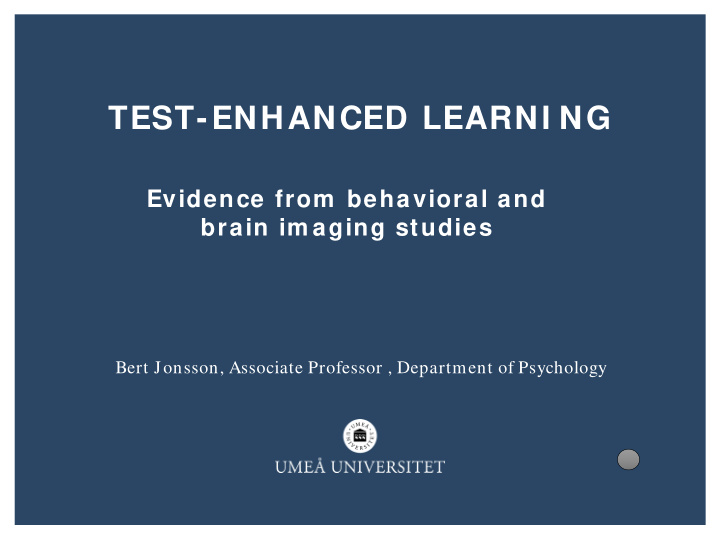



TEST-ENHANCED LEARNI NG Evidence from behavioral and brain im aging studies Bert Jonsson, Associate Professor , Department of Psychology
• “Test-re-test effects” which in pre- and post measures can be problematic .. because students remember the previous test and or encode the context
TEST-ENHANCED LEARNI NG- THE BASI C I DEA ”Test-re-test effect” = Test Enhanced Learning (retrieval practice) The main component? Memory retrieval
• Remember/ learn my phone number: 0706777612
• After one day you try to retrieve my phone number from long term memory
The make up of human blood •
The make up of human blood •
Text about ”The make up of blood” •
Key concepts in cognitive psychology” •
LEARN A SW AHI LI VOCABULARY Within- subject design • 60 Swedish-Swahili word pairs; o 30 Test enhanced learning with feedback, 30 re-reading • Mashua _______ (Test enhanced learning) • Adhama-Honor (re-reading) Follow up test Mashua ____________ Adhama____________
RETENTI ON AFTER ONE-W EEK
DI VI DED ACCORDI NG TO COGNI TI VE ABI LI TY
DI VI DED ACCORDI NG TO COGNI TI VE ABI LI TY
Functional magnetic resonance imaging (fMRI) is a neuro- imaging procedure that measures brain activity by detecting changes associated with blood flow. When an area of the brain is in use, blood flow to that region also increases.
Focus on the green bars A decrease across repetitions In the left dorsolateral prefrontal cortex
Generate a reduced cognitive load – hence providing cognitive capacity that can be used for other processes
> 5 0 0 STUDI ES Test-enhanced learning can be used across a range of materials • such as paired associates , key concepts , f acts, prose, statistics, world history, science, and m ap learning (e.g. Carpenter, Pashler, & Cepeda, 2009; Carrier & Pashler, 1992; Lyle & Crawford, 2011; Wiklund-Hörnqvist, Jonsson, & Nyberg, 2014). Test-enhanced learning has been found to be superior to other • pedagogical methods such as restudy (Roediger & Karpicke, 2006), m ind-m apping (Karpicke & Blunt, 2011) and collaborative learning (Stenlund, Jönsson, & Jonsson, 2017). These results have been confirmed in laboratory settings , • educational contexts and through brain im aging studies (see Adesope, Trevisan, & Sundararajan, 2017; Dunlosky, Rawson, Marsh, Nathan, & Willingham, 2013; Schwieren, Barenberg, & Dutke, 2017; van den Broek et al., 2016 for reviews).
I N SUM • Test-re-test = test enhanced learning (retrieval practice, practice testing) • Strengthen memory traces = enhance learning and recall • Massive amount of behavioral evidence • Support from brain imaging studies • Less is known in relation to cognition and almost nothing in relation to personality
How do we use tests in school ? A. As a “neutral” measurement of their actual level of knowledge B. As a mean to enhance learning? The application of frequent testing in classrooms can greatly improve academic performance across the curriculum.” (Roediger et al., 2015)
Recommend
More recommend